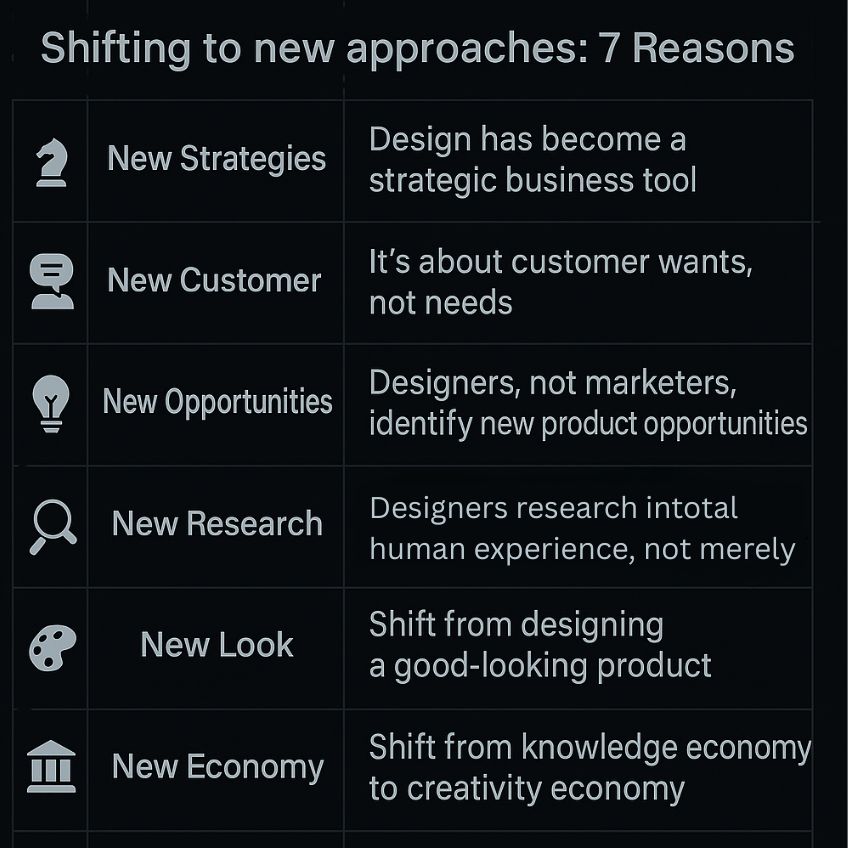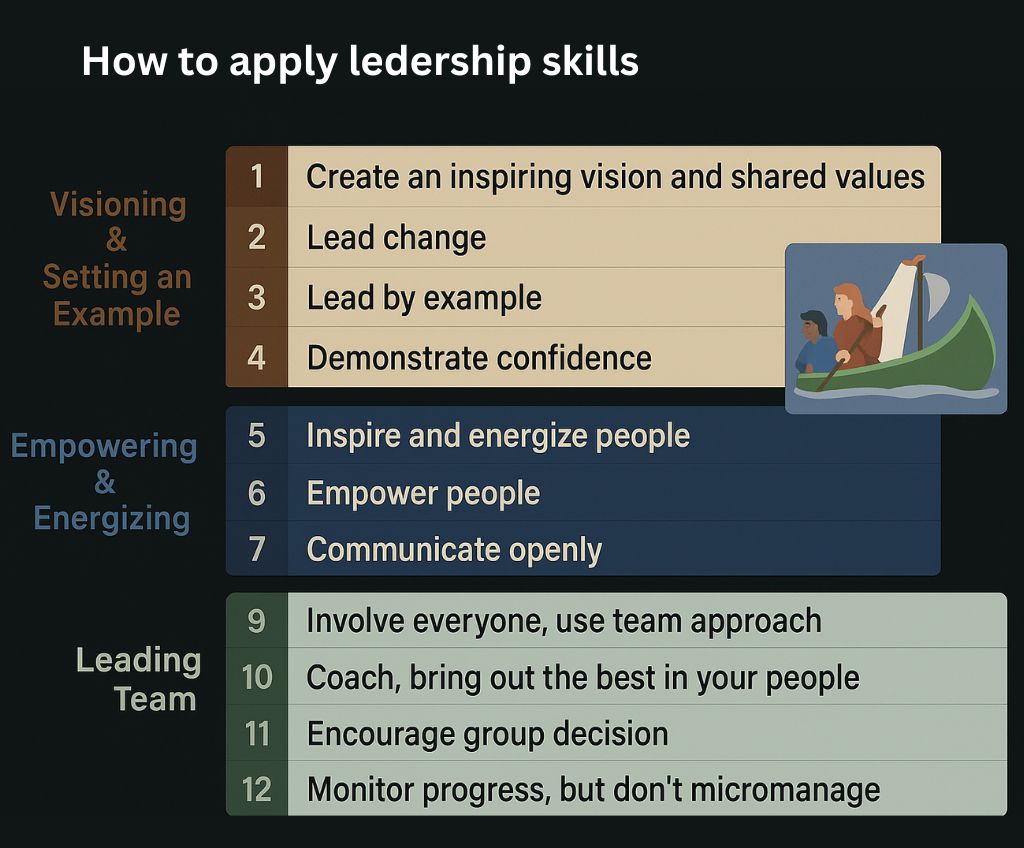Ashish Tiwari's blog
1. Observe people to understand hidden and unarticulated customer needs.
2. Live your customer's life, "walk a mile in the shoes of your customer".
3. Involve everyone, require every person, regardless of their position, to spend time on customer contact and services activities. Ask all your employee to get on board with customer-driven innovation and value innovation. Encourage experimentation and risk taking.
4. Involve customers in testing the prototype of your new product.
5. Help your employees to understand the customer's needs by involving them in listening to customer feedback after a new product launch.
6. Watch how the customers use your product to learn what works and what doesn't work.
7. Ingrain customer-driven innovation in your corporate culture and operations so deeply that is becomes a part of DNA of your company.

Reason 1: Fundamental Changes in the World Design Industry.
The industry of design is undergone deep transformation: from now on design is not only for appearance and style. Design is dramatically changing its role from being simply a tactical device to becoming a strategic business tool.
Reason 2: Transformation of Consumption Culture
Technological revolution provides customers with real power in the market. Today, the question of the utmost importance for brands is how to satisfy people who have an almost endless choice reinforced by instant access to global market.
Thus, the main issue of new product development (NPD) has dramatically changed. Until recently it was: ‘What technical / organization /financial / manufacturing possibilities for designing new product we have’(Technology-Driven Strategy).
Now it is:
> ‘What else does our customer want?
> How can we emphasize with him?
> What should we design to make our new brand/product experience as interesting, amazing, exciting as possible’ (Consumer-Driven Strategy).
Reason 3: Marketing Research vs. Design.
Research
Traditional marketing tools are good for analyzing existing market ideas. Intuitive thinking, qualitative approach used by designers is very good for imagining new possibilities.
Designers identify new product opportunities, create design briefs, conduct market research, develop a platform for further innovations and even brief advertising companies on how to promote the new product.
Reason 4: From 'Consumer' to 'Human' Experience
In contrast to artificial situations of focus group discussions, designers prefer conducting in-context observations looking at the world through their customers’ eyes, empathizing with the soul, mind and body of customer.
Those who combine design thinking with interest in user research are called human factor specialists. They research into total human – not merely customer – experience, investigate how people approach the world, what nuances of interaction with the product, brand, environment is of the most importance for them, what they expect from usage.
Reason 5: Design Thinking – the Best Tool to Tackle Tacit Knowledge
New economy requires new way of thinking to tackle ‘ill-defined’ tacit knowledge. As the real power in the market goes to the customer, companies must learn how to use effectively the tacit knowledge their people accumulated about customer wants.
Reason 6: From Product Design to Experience Design
This is a gift of co-creation, of holistic approach to life and ability to fill it with meaning, emotions and lifestyle drivers. New designers are able to create diverse human experiences, not just physical shapes, content, not simply a form, workplaces, not merely furniture.
Reason 7: From the Knowledge Economy to the Creativity Economy
In today’s era of hypercompetition companies must be very → creative to differentiate from the competition in the eyes of their customers. Companies need to learn how to manage creativity effectively. They also need very creative employees.
Feature: a specific important feature of your offer helps customer
Advantage: as compared to the competition
Benefit: to the customer (Unique extra benefit you have Vs competition)
Marketing: For promotion use visualisation that conveys feeling and is easy to remember.
Promotion Strategy 1: Take the hopes, dreams, fears and desires that already exist in the hearts of people, and focus them on your product.
Promotion Strategy 2: Create a new customer need or desire, and offer your product as the best solution.
What Is Perceived Value to the Customer?
You should charge the customer of the value provided, regardless of its cost. If the price charged for a product is commensurate with the > benefits provided or a > solution to a customer problem, then it will be considered a good value in the mind of the buyer.
Define Your Internal Core Marketing Message:
To create a business-generating marketing program, the first direction to go is inward. Before you create your outward-reaching promotional materials, you've got to get a fix on your internal Core Marketing Message – in other words, what customer value are you selling, and why should anyone care?
Describe Your Unique Advantage:
> Differentiate – describe the unique advantages of your service over your competition, and what makes you special, memorable, and stand apart from your competitors. Strong differentiation techniques include uniqueness, leadership, attribute ownership, heritage, your philosophies and values. Use testimonies to back your claim.
Experiential Marketing:
The best way to communicate to potential buyers the value of a product is to let them experience it. Creative experiential marketing, when applied correctly, will lead to greater impact for the consumer, increased effectiveness for the advertiser, and even cost savings relative to traditional advertising or marketing techniques
Case Study Apple:
Apple’s innovative value proposition “The product as an experience” stimulated great ideas when company leaders were contemplating a new business model. For instance, Apple pioneered into a new business space and defined a workable > business model Download PowerPoint presentation, pdf e-book for downloading music.
Case Study Dell Computers:
Dell Computers won business on price, but the company provides also high-quality products and services and maintains partner relationships with their customers. Actually, Dell Computers have found that the pricing was only one-third of their customers' decision-making process; the other two-thirds represented service and support.

1. Create an inspiring vision. Establish shared values. Give direction. Set stretch goals.
2. Manage change strategically. Take risks. Create change without disruption. Lead change. Manage resistance to change softly.
3. Lead by example. Practice what you preach. Be courageous. Set an example. Share risks or hardship.
4. Demonstrate confidence. Win respect. Trust without courting popularity.
5. Be enthusiastic. Motivate, inspire and energize people. Create a positive work environment.
6. Empower people. Delegate authority. Be open to ideas. Have faith in the creativity of others.
7. Communicate openly and honestly. Give clear guidelines. Set clear expectations.
8. Empathize. Be willing to discuss and solve problems. Listen with understanding. Support and help.
9. Use team approach. Facilitate cooperation. Involve everyone. Trust your team. Rely on their judgment.
10. Bring out the best in your people. Have common touch with them. Coach and provide effective feedback.
11. Permit group decisions. Help your team reach better decisions.
12. Monitor progress, but don't micromanage. Lead your team. Avoid close supervision. Do not overboss. Do not dictate. Lead team self-assessment.
In the past, we often thought of innovation as a direct path: new knowledge led straight to a new product.
But now, innovation isn't so simple or one-directional. Instead, it's like a system that grows out of many connected parts – individuals, companies, and the world around them all interacting.
To make thinking about innovation clearer, we can look at below key areas where it happens:
1. Business - How a business creates new value
2. Organization - How a company organizes itself in new ways
3. Process - How work gets done in new and better ways
4. Technology - Creating or using new tools and techniques
5. Marketing - Finding new ways to reach and connect with customers
6. Product - Introducing new or improved goods and services
Companies that get the most out of their new technologies and ideas are good at connecting those advancements with skills in other important parts of their business. This includes things like making products, getting them to customers, managing employees, marketing, and taking care of customers.
In the new rapidly changing economy the nature of value is changing, involving new ways to provide benefits, innovation and emotion. You need to think in terms of offers, to merge products and services, and to be innovative to give customers a value-added experience (extra benifits).
In the world of business, beating Competition via a deep strategy comes later, but first a market defense mechanism is reuired to build around your product to avoid getting copied or replicated initially.
Necessity is mother of invention - Not just customer problems or soltions. Invention giveway you easiest way to create competition barriers. You can invent yourself, hire someone to invent or lease an invention.
The critical thinking should not be just around innovating extra unique benefits for your customers against competition offering, but how do you create I.P (Intellectual Property) of your product or services and packaage it into life long economic rents.
Patents, Copyrights and Trademarks are imperative and fundamental to long term business growth.
Its just not what and how you create innovative product or services, but how well you guard them via I.P (intellectual property) - Both are equally important.
Especially in the world of Technology and Mobile Apps, many enterprenuers have a wrong notion that unique processes of softwares cannot be patented.